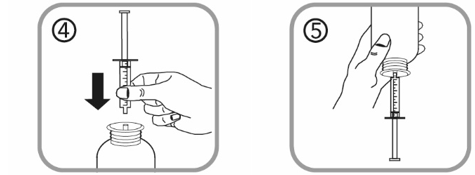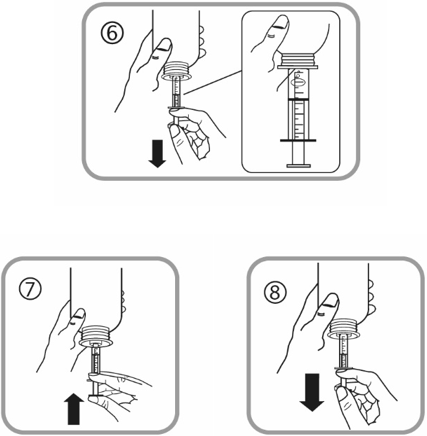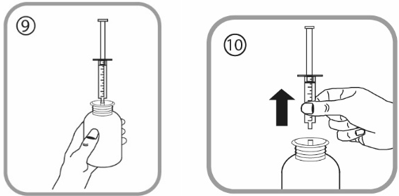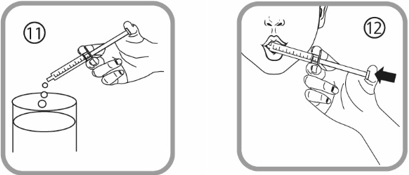2. What should I know before I use Vimpat®?
Do not use if you have ever had an allergic reaction to lacosamide or any of the ingredients
listed at the end of the CMI.
Talk to your doctor if you have any other medical conditions, take any other medicines,
or are pregnant or plan to become pregnant or are breastfeeding. For more information, see Section
2. What should I know before I use Vimpat®? in the full CMI.
3. What if I am taking other medicines?
4. How do I use Vimpat®?
Your doctor will tell you how much Vimpat® you will need to take each day. This may depend on your condition, your body weight,
and whether or not you are taking any other medicine.
Use the syringe in the pack to take Vimpat® oral solution.
5. What should I know while using Vimpat®?
|
Things you should do
|
Remind any doctor, dentist or pharmacist you visit that you are using barbiturates
(such as phenobarbitone), or any other antiepileptic medicines (such as carbamazepine,
lamotrigine or levetiracetam
Notify your doctor straightaway if you;
have increase of seizures or,
have symptoms of depression or thoughts of harming yourself.
|
|
Things you should not do
|
Do not stop taking Vimpat® or change the dosage unless your doctor tells you to.
|
|
Driving or using machines
|
Vimpat® may cause dizziness and drowsiness. This is more frequent at the beginning of treatment
or after an increase in the dose. If you are feeling dizzy or drowsy, do not drive
a car, operate machinery, or do anything else that could be dangerous.
|
|
Drinking alcohol
|
As a safety precaution, do not take Vimpat® with alcohol
|
|
Looking after your medicine
|
Keep your tablets and oral solution in a cool dry place where the temperature stays
below 30°C.
Oral solution - do not refrigerate or freeze. Disregard after 2 months of opening.
Tablets - Keep your tablets in the pack until it is time to take them.
|
6. Are there any side effects?
Common side effects include dizziness or problems with balance or coordination headache
nausea (feeling sick) or vomiting feeling tired, drowsy or sleepy forgetfulness tremors
and itching.
Serious side effects include depression, thoughts of harming yourself, more frequent
seizures, fainting or feeling lightheaded and heart palpitations or a rapid or irregular
pulse.
Active ingredient(s):
lacosamide (phonetic pronunciation – “la-KOE-sa-mide”)
Full Consumer Medicine Information (CMI)
This leaflet provides important information about using Vimpat®. You should also speak to your doctor or pharmacist if you would like further information
or if you have any concerns or questions about using Vimpat
®
.
Where to find information in this leaflet:
1. Why am I using Vimpat®?
2. What should I know before I use Vimpat®?
3. What if I am taking other medicines?
4. How do I use Vimpat®?
5. What should I know while using Vimpat®?
6. Are there any side effects?
7. Product details
1. Why am I using Vimpat®?
Vimpat
®
contains the active ingredient lacosamide. Vimpat® is an antiepileptic. These medicines are thought to work by controlling brain chemicals
which send signals to nerves so that seizures do not happen.
Vimpat
®
is used in patients to control epilepsy. Epilepsy is a condition where you have repeated
seizures. There are many different types of seizures, ranging from mild to severe.
2. What should I know before I use Vimpat®?
Warnings
Do not use Vimpat
®
if:
You are allergic to lacosamide, or any of the ingredients listed at the end of this
leaflet.
Always check the ingredients to make sure you can use this medicine.
If you have a heart condition causing an uneven heartbeat.
Check with your doctor if you:
Have any other medical conditions such as;
heart problems,
kidney problems,
liver problems,
and any other mental health condition, such as depression.
take any medicines for any other condition especially;
barbiturates (such as phenobarbitone)
or any other antiepileptic medicines (such as carbamazepine, lamotrigine or levetiracetam)
have allergies to any other substances, such as foods, preservatives or dyes.
During treatment, you may be at risk of developing certain side effects. It is important
you understand these risks and how to monitor for them. See additional information
under Section
6. Are there any side effects?
Pregnancy and breastfeeding
Check with your doctor if you are pregnant or intend to become pregnant.
Talk to your doctor if you are breastfeeding or intend to breastfeed. Vimpat® may affect your developing baby if you take it during pregnancy. However, it is very
important to control your seizures while you are pregnant. Your doctor will outline
and weigh up all the risks and benefits of taking Vimpat® during pregnancy and/or breastfeeding to help decide whether or not you should take
it.
Children and Adolescents
Vimpat® is not recommended for use in children under the age of 4 years as its safety and
effectiveness has not been established in this age group.
Vimpat® is used in combination with other medicines to control epilepsy in children 4 to
16 years of age.
Adolescents and Adults
Vimpat® can only be used by itself in patients over the age of 16 years.
3. What if I am taking other medicines?
Tell your doctor or pharmacist if you are taking any other medicines, including any
medicines, vitamins or supplements that you buy without a prescription from your pharmacy,
supermarket or health food shop.
Some medicines may interfere with Vimpat
®
and affect how it works.
These medicines include;
medicines to treat heart problems,
and medicine which may have an effect on your heartbeat such as carbamazepine, lamotrigine
or pregabalin.
Vimpat® does not interact with the oral contraceptive pill. However, you may be given Vimpat® together with other antiepileptic medicines that do interact and may affect the effectiveness
of your contraceptive. Your doctor may advise you to use an additional method of contraception
if you take Vimpat® with other antiepileptic medicines.
Check with your doctor or pharmacist if you are not sure about what medicines, vitamins
or supplements you are taking and if these affect Vimpat
®
.
4. How do I use Vimpat®?
How much to take / use
Follow all directions given to you by your doctor carefully. They may differ from
the information contained in this leaflet.
Your doctor will tell you how much Vimpat® you will need to take each day. This may depend on your condition, your body weight,
and whether or not you are taking any other medicines.
Your doctor may start you on a low dose of Vimpat® first of 50 mg or 100 mg twice a day. Your doctor may slowly increase your dose up
to a maximum of 300 mg twice a day, until you are taking enough to control your epilepsy
and you are not having any seizures.
For use in children weighing less than 50kg, the doctor may start you on a low dose
of Vimpat® oral solution first of 0.1 mL/kg twice a day. The doctor may slowly increase your
dose up to a maximum of 0.6 mL/kg twice a day, until you are taking enough to control
your epilepsy and you are not having any seizures.
If you do not understand the instructions on the pack, ask your doctor or pharmacist
for help.
When to take it
Take Vimpat® twice a day, once in the morning and once at night. Take it at about the same time
each day.
Taking your medicine at the same time each day will have the best effect. It will
also help you remember when to take it.
It does not matter if you take this medicine before or after food.
How to take Vimpat®
Tablets
Swallow Vimpat® tablets whole with a glass of water.
Oral Solution
Use only the syringe within this pack. If you need to take a dose greater than 10
mL (100 mg), use the syringe a second time to draw up the correct amount of solution.
Open the bottle by pressing the cap while turning it anti-clockwise (1).

Follow these steps the first time you take Vimpat
®
:
Take off the adaptor from the oral syringe (2).
Put the adaptor into the top of the bottle (3). Make sure it is fixed well in place.
You do not need to remove the adaptor after use.

Follow these steps each time you take Vimpat
®
:
Put the oral syringe into the adaptor opening (4).
Turn the bottle upside down (5).

Hold the bottle upside down in one hand and use the other hand to fill the oral syringe.
Pull the plunger down to fill the oral syringe with a small amount of solution (6).
Push the plunger up to get rid of any bubbles (7).
Pull the plunger down to the millilitre (mL) dose marker prescribed by your doctor
(8). The plunger may rise back up the barrel on the first dosage.

Turn the bottle the right way up (9).
Take the oral syringe out of the adaptor (10).

Empty the contents of the oral syringe into a little water by pushing the plunger
to the bottom of the oral syringe (11) – you will then need to drink all of the water
(add just enough to make it easy to drink) or;
Drink the solution directly from the oral syringe without water (12) – drink the whole
contents of the oral syringe.

Close the bottle with the plastic screw cap (you do not need to remove the adaptor).
To clean the syringe, rinse with cold water only, moving the plunger several times
up and down to take up and expel the water, without separating the two components
(13).
Keep the bottle, the oral syringe, and the leaflet in the carton.

If you forget to use Vimpat®
Vimpat® should be used regularly at the same time each day. Then, take your next dose at
your regular scheduled time. Call your doctor if you are not sure what to do.
Do not take a double dose to make up for the dose you missed.
This may increase the chance of you getting an unwanted side effect.
Contact your doctor if you have missed one or more doses.
If you have trouble remembering to take your medicine, ask your pharmacist for some
hints.
If you use too much Vimpat®
If you think that you have used too much Vimpat®, you may need urgent medical attention.
You should immediately:
phone the Poisons Information Centre
(by calling 13 11 26), or
contact your doctor, or
go to the Emergency Department at your nearest hospital.
You should do this even if there are no signs of discomfort or poisoning.
5. What should I know while using Vimpat®?
Things you should do:
Call your doctor straight away if you:
if you notice an increase in seizures.
If you have symptoms of depression or thoughts of harming yourself.
If you are about to start on any new medicine, tell your doctor, dentist or pharmacist
that you are taking Vimpat®.
Before you have any surgery or emergency treatment, tell your doctor or dentist that
you are taking Vimpat®.
Tell your doctor if you feel Vimpat® is not helping your condition. Your doctor may need to change your medicine.
Tell your doctor if, for any reason, you have not taken this medicine exactly as prescribed.
Otherwise, your doctor may change your treatment unnecessarily.
If you become pregnant while taking this medicine, tell your doctor.
Be sure to keep all of your doctor’s appointments so that your progress can be checked.
Your doctor will check your progress and may want to take some tests from time to
time. This helps to prevent unwanted side effects.
Remind any doctor, dentist or pharmacist you visit that you are using Vimpat®.
Things you should not do
Do not give Vimpat® to anyone else, even if their symptoms seem similar to yours or they have the same
condition as you.
Do not take Vimpat® to treat any other complaints unless your doctor tells you to.
Do not stop taking Vimpat® or change the dosage unless your doctor tells you to.
Stopping Vimpat® suddenly may cause unwanted side effects or make your condition worse.
Driving or using machines
Be careful before you drive or use any machines or tools until you know how Vimpat
®
affects you.
Vimpat® may cause dizziness and drowsiness, like other antiepileptic medicines. This is more
frequent at the beginning of treatment or after an increase in the dose.
If you are feeling dizzy or drowsy, do not drive a car, operate machinery, or do anything
else that could be dangerous.
Drinking alcohol
Tell your doctor if you drink alcohol.
As a safety precaution, do not take Vimpat® with alcohol.
Looking after your medicine
Keep your tablets and oral solution in a cool dry place where the temperature stays
below 30°C.
Do not store Vimpat® or any other medicine in the bathroom or near a sink.
Do not leave your medicine on a windowsill or in the car on hot days.
Tablets - Keep your tablets in the pack until it is time to take them. If you take the tablets
out of the pack, they will not keep well.
Oral solution - do not refrigerate or freeze. Disregard after 2 months of opening.
Follow the instructions in the carton on how to take care of your medicine properly.
Keep it where young children cannot reach it.
When to discard your medicine
Oral solution - Disregard after expiry date, or 2 months after opening the bottle.
Getting rid of any unwanted medicine
If you no longer need to use this medicine or it is out of date, take it to any pharmacy
for safe disposal.
Do not use this medicine after the expiry date.
6. Are there any side effects?
All medicines can have side effects. If you do experience any side effects, most of
them are minor and temporary. However, some side effects may need medical attention.
See the information below and, if you need to, ask your doctor or pharmacist if you
have any further questions about side effects.
Less serious side effects
|
Less serious side effects
|
What to do
|
|
Nervous system related:
dizziness or problems with balance or coordination
headache
forgetfulness
tremors
feelings of depression
feeling aggressive or agitated
spinning sensations
having trouble sleeping
Vision related:
double vision or blurred vision
Digestion system related:
nausea (feeling sick) or vomiting
Other:
feeling tired, drowsy or sleepy
itchiness
|
Speak to your doctor if you have any of these less serious side effects and they worry
you.
|
Serious side effects
|
Serious side effects
|
What to do
|
|
Nervous system related:
thoughts of harming yourself
more frequent or more severe seizures
fainting or feeling lightheaded
Heart related:
heart palpitations or a rapid or irregular pulse
Allergic reaction related:
shortness of breath
wheezing or difficulty breathing
swelling of the face, lips, tongue or other parts of the body
rash, itching or hives on the skin.
|
Call your doctor straight away or go straight to the Emergency Department at your
nearest hospital if you notice any of these serious side effects.
|
Tell your doctor or pharmacist if you notice anything else that may be making you
feel unwell.
Other side effects not listed here may occur in some people.
Reporting side effects
Always make sure you speak to your doctor or pharmacist before you decide to stop
taking any of your medicines.
7. Product details
This medicine is only available with a doctor's prescription.
What Vimpat® contains
|
Active ingredient
(main ingredient)
|
lacosamide
|
|
Other ingredients
(inactive ingredients)
|
Tablets:
colloidal anhydrous silica
crospovidone
hydroxypropylcellulose
magnesium stearate
microcrystalline cellulose
macrogol 3350
polyvinyl alcohol
purified talc
titanium dioxide
The following strengths also contain:
50 mg - iron oxide red C177491, iron oxide black C177499, indigo carmine C173015
100 mg - iron oxide yellow C177492
150 mg -iron oxide yellow C177492, iron oxide red C177491, iron oxide black C177499
200 mg - indigo carmine C173015
Oral Solution:
glycerol
carmellose sodium,
sorbitol solution (70 per cent, crystallising)
macrogol 4000,
sodium chloride,
citric acid, acesulfame potassium
sodium methyl hydroxybenzoate
Strawberry flavour 501440 T
Masking flavour 501521 T
water- purified
|
|
Potential allergens
|
Oral solution - sorbitol and hydroxybenzoates
|
Do not take this medicine if you are allergic to any of these ingredients.
What Vimpat® looks like:
Vimpat® Tablet 50 mg: Pinkish, oval debossed with ‘SP’ on one side and '50' on the other
side. AUST R 196449
Vimpat® Tablet 100 mg: Dark yellow, oval debossed with ‘SP’ on one side and ‘100’ on the
other side. AUST R 196450
Vimpat® Tablet 150 mg: Salmon, oval debossed with ‘SP’ on one side and ‘150’ on the other
side. AUST R 196451
Vimpat® Tablet 200 mg: Blue, oval debossed with ‘SP’ on one side and ‘200’ on the other side.
AUST R 196452
Vimpat® Oral Solution 10 mg/mL- Colourless to yellow or yellow brown liquid. AUST R 286810
Who distributes Vimpat®
Australian Sponsor:
UCB Pharma
A division of UCB Australia Pty Ltd
Phone: +613 9828 1800
NZ Sponsor:
Seqirus (NZ) Ltd
PO Box 62 590
Greenlane
Auckland 1546
Phone: 0800 502 757
This leaflet was prepared in July 2025